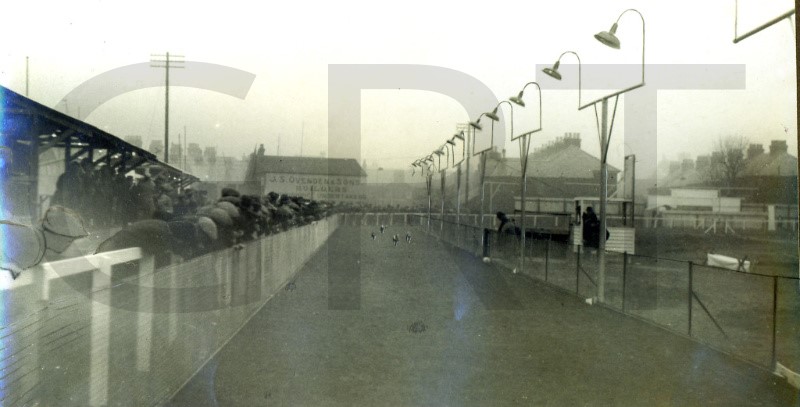Alfred Road, Buckland, Dover, Kent.
POSTCODE———————————CT16 2AD
LOCATED————————————About one and a half miles, north west of Dover town centre in a district called Buckland. The stadium was hemmed in between Alfred Road and Brookfield place, north of the River Dover.
ORIGINAL SITE—————————–Part of the site was a continuation of Albert Road and the other part was wasteland adjacent to Brookfield Place.
DATE CONSTRUCTED——————-Autumn 1932.
DATE VENUE OPENED——————December 1932.
Meaning other sports may have taken place prior to the arrival of Greyhound Racing.
FIRST MEETING—————————December 26th 1932.
Greyhound Racing only.
LICENSED OR INDEPENDENT———Independent
All venues covered would have to be licensed with the government, licensed suggested in this section would refer to tracks operating under NGRC Rules.
INSIDE OR OUTSIDE HARE TYPE——A trackless hare driven by a car engine.
Please note that the Electric Hare suggested is only a guidance and would have been in operation for a certain amount of time at this venue. Although it is not necessarily guaranteed that it was operational all the time, as other types of lure may have been used and updated as time progressed.
DISTANCES———————————–320 and 500 yards.
Please note that most racing venues distances had become varied throughout the years, the ones given above were at once point set and offers only a guidance to the track size.
CIRCUMFERENCE—————————411 yards.
Please note that alterations at most racing venues throughout its existence would see that the circumference of the track would vary, the one shown above offers only a guidance to the track size.
BIG RACE NAMES—————————None found.
STADIUM SHARED WITH——————Whippet Racing.
LAST MEETING——————————-March 1935.
Greyhound Racing only.
STADIUM CLOSURE DATE—————-March 1935.
Meaning other sports may have taken place after Greyhound Racing had ceased.
STADIUM DEMOLITION——————–1935
BUILT ON SITE——————————–50 new houses were built on the site during the following years which became known as Willow Walk and became an extension to Alfred Road.
In some cases, structure’s that originally covered the venue after the stadium had been demolished, may have been themselves demolished too, so the one described is more likely to be the one which now presently covers the site.
EVIDENCE LEFT TODAY——————–Nothing known of.
FURTHER COMMENTS———————If you check Google Earth, the property built on the old stadium site, gives an indication of wear it lied. The oval track was had very tight bends due to it being hemmed in by existing housing and the River Dover. It also promoted five meetings per week.




You could say that the Kent town of Dover is more famous for its white cliffs, and its graphical position that makes it the closest English town the French coast, but it could also boast that it once staged greyhound racing. Known as the Dover and District Greyhound Stadium, it was situated roughly one and a half miles north west of Dover in a district known as Buckland.
It was constructed during late 1932 on a section of waste land known as Willow Walk Meadow, a narrow strip of land situated between terraced houses and the River Dover. Once complete, the track housed two covered stands, track lighting and kennels for company owned dogs. The space remaining left the track compromising of two very tight bends indeed, with one bend being tighter than the other, but the long galloping straights made the racing distances acceptable. The track had a circumference of 411 yards, which created distances of 320 and 500 yards, along with a trackless type hare driven by a car engine.
Opening up as an independent flapping track, the new track staged a double header meeting on Boxing Day 1932, with one in the morning and one in the evening, both filling the card with six events each. It also staged not only greyhounds but also whippet racing too, with the majority of the greyhounds being supplied by the greyhound company itself. But the two meetings attracted moderate crowds only, and with five meetings per week scheduled, crowd numbers remained very low. But the short existence of the track was never short of controversy, a report in the local press reported that 27 greyhounds died from suffocation, while being transported in the back of a furniture van from Dover to Rochester.
More bad news was to follow by the end of 1934, with the press stating that the 23 year old stadium’s proprietor had declared himself bankrupt, forcing the council to order a winding up order on the greyhound company. Greyhound Racing at the Dover track ceased by the end of 1934, and with no signs of any further activities, the stadium was demolished the following year.
Over the next coming years, fifty new houses had been built on the site as part of the scheme to extend Alfred Street. Alfred Street still remains, and so does the houses that covered the site, but unfortunately nothing remains to remind us of a greyhound stadium ever being there. Yet possibly its only proof of existence, lies in satellite views, which shows the roof tops of those houses being slightly different to those that surround it, which offers the shape of where the track once lay.
A programme, photograph or even memorabilia for this track is required for this page, if you can help please contact me.

Recent Comments